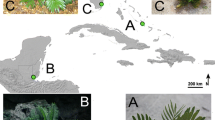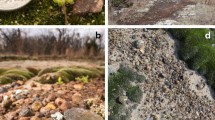Abstract
Sibara filifolia (Brassicaceae), Santa Cruz Island Rock Cress, an endangered annual plant endemic to the California Channel Islands which was presumed extinct for nearly 50 years, is currently known from only a few small patches on San Clemente Island (SCl) and Santa Catalina Island (SCa). In addition to protecting extant populations, recovery efforts have included ex situ seed collections to hedge against stochastic population losses. We examined genetic diversity and population structure in the wild and the effect of sampling intensity on the genetic diversity of ex situ seed collections using 13 species-specific microsatellite loci. Much of the genetic variation on each island consisted of rare alleles; 33 % (SCl) or 56 % (SCa) of the non-fixed alleles occurred at frequencies ≤0.05. Patches on SCl were genetically depauperate (mean HO = 0.002) compared to patches on SCa (mean HO = 0.344). One patch on SCl was genetically distinct, while the remaining four patches were genetically indistinguishable. The three patches on SCa were genetically distinct from those on SCl, but not from one another. Simulated sampling for the ex situ seed collections found that 10 individuals was sufficient to capture 90 % of the diversity for normalized measures (NE, HO, and HE) in a depauperate (SCl) population, while 30 individuals was necessary in a diverse (SCa) population. However, sampling 125 (SCl) or 60 (SCa) individuals was necessary to capture 90 % of all the alleles present. These findings indicate that theoretical guidelines for ex situ seed collections that recommend targeting 50 individuals per population overestimate the sampling effort required to adequately preserve common alleles, but may underestimate the effort necessary to capture most alleles in wild populations.





Similar content being viewed by others
References
Allendorf FW (1986) Genetic drift and the loss of alleles versus heterozygosity. Zool Biol 5:181–190
Brown AHD, Briggs JD (1991) Sampling strategies for genetic variation in ex situ collections of endangered plant species. In: Falk DA, Holsinger KE (eds) Genetics and conservation of rare plants. Oxford University Press, New York, pp 99–119
Bureau of Land Management (2012) Technical protocol for the collection, study, and conservation of seeds from native plant species for seeds of success, Washington, D.C. http://www.nps.gov/plants/sos/index.htm. Accessed Dec 2013
Cornuet JM, Luikart G (1996) Description and power analysis of two tests for detecting recent population bottlenecks from allele frequency data. Genetics 144:2001–2014
CPC (Center for Plant Conservation) (2010) Sibara filifolia. Center for Plant Conservation. http://www.centerforplantconservation.org/Collection/CPC_ViewProfile.asp?CPCNum=3953. Accessed 1 Oct 2012
Da Silva A, Gaillard JM, Yoccoz NG, Hewison AJM, Galan M, Coulson T, Allaine D, Vial L, Delorme D, Van Laere G, Klein F, Luikart G (2009) Heterozygosity-fitness correlations revealed by neutral and candidate gene markers in roe deer from a long-term study. Evolution 63:403–417
Di Rienzo A, Peterson AC, Garza JC, Valdes AM, Slatkin M, Freimer N (1994) Mutational processes of simple sequence repeat loci in human population. Proc Natl Acad Sci USA 91:3166–3170
Earl DA, Vonholdt BM (2012) STRUCTURE HARVESTER: a website and program for visualizing STRUCTURE output and implementing the Evanno method. Conserv Genet Resour 4:359–361
Evanno G, Regnaut S, Goudet J (2005) Detecting the number of clusters of individuals using the software STRUCTURE: a simulation study. Mol Ecol 14:2611–2620
Excoffier L, Smouse PE, Quattro JM (1992) Analysis of molecular variance inferred from metric distances among DNA haplotypes: application to human mitochondrial DNA restriction data. Genetics 131:479–491
Excoffier L, Laval G, Schneider S (2005) Arlequin ver. 3.0: an integrated software package for population genetics data analysis. Evol Bioinform Online 1:47–50
Falush D, Stephens M, Pritchard JK (2003) Inference of population structure using multilocus genotype data: linked loci and correlated allele frequencies. Genetics 164:1567–1587
Furches MS, Wallace LE, Helenurm K (2009) High genetic divergence characterizes populations of the endemic plant Lithophragma maximum (Saxifragaceae) on San Clemente Island. Conserv Genet 10:115–126
Gao H, Williamson S, Bustamante CD (2007) A Markov chain Monte Carlo approach for joint inference of population structure and inbreeding rates from multilocus genotype data. Genetics 176:1635–1651
Gapare WJ, Yanchuk AD, Aitken SN (2007) Optimal sampling strategies for capture of genetic diversity differ between core and peripheral populations of Picea sitchensis (Bong.) Carr. Conserv Genet 9:411–418
Godefroid S, Vyver A, Vanderborght T (2009) Germination capacity and viability of threatened species collections in seed banks. Biodivers Conserv 19:1365–1383
Guerrant EO, Fiedler PL, Havens K, Maunder M (2004a) Revised genetic sampling guidelines for conservation collections of rare and endangered plants. In: Guerrant EO, Havens K, Maunder M (eds) Ex situ plant conservation: supporting species survival in the wild. Island Press, Washington, DC, pp 419–438
Guerrant EO, Havens K, Maunder M (2004b) Ex situ plant conservation: supporting species survival in the wild. Island Press, Washington, DC
Helenurm K (2003) Genetic diversity in the rare insular endemic Sibara filifolia (Brassicaceae). Madrono 50:181–186
Henry RJ (2006) Plant conservation genetics. Food Products Press, New York
Hubisz MJ, Falush D, Stephens M, Pritchard JK (2009) Inferring weak population structure with the assistance of sample group information. Mol Ecol Resour 9:1322–1332
Jump AS, Marchant R, Penuelas J (2009) Environmental change and the option value of genetic diversity. Trends Plant Sci 14:51–58
Knopp T, Cano JM, Crochet PA, Merila J (2007) Contrasting levels of variation in neutral and quantitative genetic loci on island populations of moor frogs (Rana arvalis). Conserv Genet 8:45–56
Lauretto MS, Nakano F, Faria SR, Pereira CAB, Stern JM (2009) A straightforward multiallelic significance test for the Hardy–Weinberg equilibrium law. Genet Mol Biol 32:619–625
Lawrence MJ (2002) A comprehensive collection and regeneration strategy for ex situ conservation. Genet Resour Crop Evol 49:199–209
Lawrence MJ, Marshall DF, Davies P (1995) Genetics of genetic conservation. I. Sample size when collecting germplasm. Euphytica 84:89–99
Leinonen T, O’hara RB, Cano JM, Merila J (2008) Comparative studies of quantitative trait and neutral marker divergence: a meta-analysis. J Evolution Biol 21:1–17
Li DZ, Pritchard HW (2009) The science and economics of ex situ plant conservation. Trends Plant Sci 14:614–621
Lockwood DR, Richards CM, Volk GM (2007) Probabilistic models for collecting genetic diversity: comparisons, caveats, and limitations. Crop Sci 47:861–868
Luikart G, Cornuet JM (1998) Empirical evaluation of a test for identifying recently bottlenecked populations from allele frequency data. Conserv Biol 12:228–237
Marshall DR, Brown AHD (1975) Optimum sampling strategies in genetic conservation. In: Frankel OH, Hawkes JG (eds) Crop genetic resources for today and tomorrow. Cambridge University Press, Cambridge Eng.; New York, pp 53–80
McGlaughlin ME, Wallace LE, Helenurm K (2008) Isolation of microsatellite loci from the endangered plant Sibara filifolia (Brassicaceae). Mol Ecol Resour 8:367–369
McGlaughlin ME, Wallace LE, Wheeler GL, Bresowar G, Riley L, Britten NR, Helenurm K (2014) Do the island biogeography predictions of MacArthur and Wilson hold when examining genetic diversity on the near mainland California Channel Islands? Examples from endemic Acmispon (Fabaceae). Bot J Linn Soc 174:289–304
Neel MC, Cummings MP (2003) Effectiveness of conservation targets in capturing genetic diversity. Conserv Biol 17:219–229
Nybom H (2004) Comparison of different nuclear DNA markers for estimating intraspecific genetic diversity in plants. Mol Ecol 13:1143–1155
Ouborg NJ, Pertoldi C, Loeschcke V, Bijlsma R, Hedrick PW (2010) Conservation genetics in transition to conservation genomics. Trends Genet 26:177–187
Peakall R, Smouse PE (2012) GenAlEx 6.5: genetic analysis in Excel. Population genetic software for teaching and research—an update. Bioinformatics 28:2537–2539
Piry S, Luikart G, Cornuet JM (1999) BOTTLENECK: a computer programme for detecting recent reductions in the effective population size using allele frequency data. J Hered 90:502–503
Pritchard JK, Stephens M, Donnelly P (2000) Inference of population structure using multilocus genotype data. Genetics 155:945–959
Raymond M, Rousset F (1995) Genepop (version-1.2)—population-genetics software for exact tests and ecumenicism. J Hered 86:248–249
Reed DH, Frankham R (2001) How closely correlated are molecular and quantitative measures of genetic variation? A meta-analysis. Evolution 55:1095–1103
Reed DH, Frankham R (2003) Correlation between fitness and genetic diversity. Conserv Biol 17:230–237
Richards CM, Lockwood DR, Volk GM, Walters C (2010) modeling demographics and genetic diversity in ex situ collections during seed storage and regeneration. Crop Sci 50:2440
Riley L, McGlaughlin ME, Helenurm K (2010) Genetic diversity following demographic recovery in the insular endemic plant Galium catalinense subspecies acrispum. Conserv Genet 11:2015–2025
Rust R, Menke A, Miller D (1985) A biogeographic comparison of the bees, sphecid wasps, and mealybugs of the California Channel Islands (Hymenoptera, Homoptera). In: Miller D, Menke A (eds.) Entomology of the California Channel Islands: proceedings of the first symposium, Santa Barbara Museum of Natural History, Santa Barbara, California, pp 29–59
Schaal B, Leverich WJ (2004) Population genetic issues in ex situ plant conservation. In: Guerrant EO, Havens K, Maunder M (eds) Ex situ plant conservation: supporting species survival in the wild. Island Press, Washington, DC, pp 267–285
Schoen DJ, Brown AHD (2001) The conservation of wild plant species in seed banks. Bioscience 51:960–966
Secretariat of the Convention on Biological Diversity (2009) The convention on biological diversity plant conservation report: a review of progress in implementing the global strategy of plant conservation (GSPC). Secretariat of the Convention on Biological Diversity, Montreal
USFWS (1997) Determination of endangered status for three plants from the Channel Islands of southern California. Fed Reg 62:42692–42702
USFWS (2012) Sibara filifolia (Santa Cruz Island rock-cress) 5-year review: summary and evaluation. (ed. USFWS Carlsbad Fish and Wildlife Office C, CA), http://ecos.fws.gov/speciesProfile/profile/speciesProfile.action?spcode=Q1OF
Wallace LE, Helenurm K (2009) Has herbivory negatively impacted genetic variability in the flora of the California Channel Islands? Insights from Crossosoma Californicum (Crossosomataceae). Int J Plant Sci 170:311–322
Walters C (2004) Principles for preserving germplasm in gene banks. In: Guerrant EO, Havens K, Maunder M (eds) Ex situ plant conservation: supporting species survival in the wild. Island Press, Washington, DC, pp 113–138
Acknowledgments
This research was funded by the Natural Resource Office, Staff Civil Engineer, Naval Air Station, North Island, San Diego, California, and the University of Northern Colorado. The Catalina Island Conservancy generously provided access and logistical support for all sampling conducted on Santa Catalina Island. We would like to thank two anonymous reviewers for comments on earlier versions of this paper.
Author information
Authors and Affiliations
Corresponding author
Electronic supplementary material
Below is the link to the electronic supplementary material.
Rights and permissions
About this article
Cite this article
McGlaughlin, M.E., Riley, L., Brandsrud, M. et al. How much is enough? Minimum sampling intensity required to capture extant genetic diversity in ex situ seed collections: examples from the endangered plant Sibara filifolia (Brassicaceae). Conserv Genet 16, 253–266 (2015). https://doi.org/10.1007/s10592-014-0655-3
Received:
Accepted:
Published:
Issue Date:
DOI: https://doi.org/10.1007/s10592-014-0655-3




